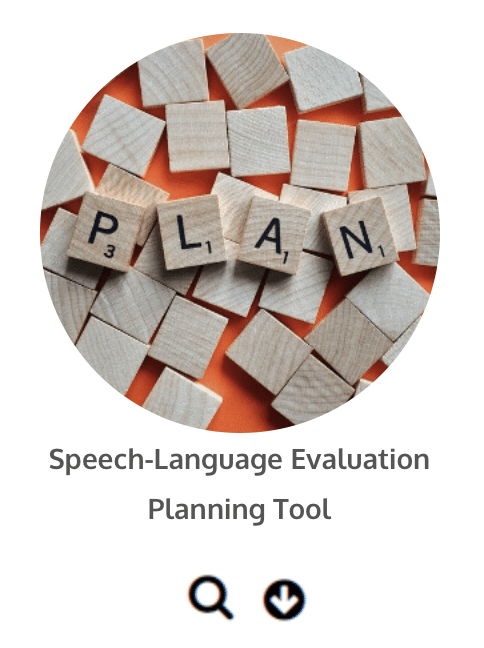The process of planning, executing, and writing an evaluation is one of the most challenging elements of the job for many speech-language pathologists. Yet, evaluations are a critical part of our job–the part where we make a decision about whether a person has a speech or language disorder. These are big decisions, and they take time.
I think that one of the reasons speech-language pathologists get stressed about doing evaluations is because they DO take time, yet not a lot of time is granted to do them. Why is this? In the clinic and hospital settings, it’s because insurance reimbursements for evaluations are small. In the school setting, it’s because caseloads are large and other responsibilities are great.
Where does that leave us? It means we have to figure out how to do evaluations as efficiently as possible while still maintaining our ability to make confident diagnostic decisions. I’ll share some of the ways I have figured out how to do this in my 25 years in the field.
Five Ways to Save Time on Speech and Language Evaluations
1. Only go through the referral packet once.
Maximize the information that comes to you before the evaluation to expedite report writing and help to select the measures that will most efficiently lead you to your diagnostic decision.
How many times have you picked up a folder just prior to an evaluation to quickly determine what testing tools you will use? It has happened to all of us. And, while we can manage that situation, it isn’t ideal because it is inefficient.
How can we use the referral packet more effectively?
Make some time a day or two prior to the evaluation to review the referral packet, make notes, and contact the parent. This is a great use of your time because you’ll typically have questions for the parents as you go through the referral packet. This is when I ask the parent what their biggest concerns about communication are, gather information about language exposure and use, and make sure they know when and where
2. When you are going through your referral packet, go ahead and write up the first half of your report.
Tell me how many times you have gone through the referral packet prior to testing and then you have gone through the referral packet AGAIN when you sat down to write up your report. Why do it twice?
I now pull the pertinent referral information from the folder prior to the evaluation and put it straight into my report template. It takes me 20-30 minutes and saves me loads of time on the back end.
3. Only test what NEEDS to be tested.
One of the biggest mistakes clinicians, especially those newer to the field, make in conducting speech-language evaluations is that they DO TOO MUCH TESTING.
Why? I can think of a few reasons.
- Sometimes our places of employment provide testing guidelines that “require” two standard scores in each area and informal data to boot. I’ll say this…if your employer requires a lot of testing that is not necessary to do your job effectively, advocate, advocate, advocate. Talk to your supervisor, manager, team lead. I will tell you that there is not a leader out there who does not want to hear, “I can do my job just as effectively in less time than I am currently doing it.”
- Sometimes insurance companies have requirements for standardized scores that don’t make any sense. Several years ago, we sat down to multiple meetings with a group that was requiring standardized scores for students who came from language backgrounds for which there are no standardized tests. Eventually, we convinced them that we needed to change the rules.
- We feel the need to administer every subtest of a testing tool, when that may not be necessary. There is no rule that you have to administer every single subtest of a test. How many times have you done that and then realized that some of the subtests did not play into your diagnostic decision making at all?
Let’s expand on the subtests for speech and language evaluations a bit.
Most tests have standard scores for individual subtests and composite scores for groups of subtests. For example, the CELF-4-Spanish for Ages 5-8 has 10 subtests for which you can get a standard score and percentile and 6 composite scores for Core Language, Receptive Language, Expressive Language, Language Content, Language Structure, and Working Memory. You need not do all of them to do a complete speech-language evaluation. In fact, the Language Content Score requires the Expressive Vocabulary subtests to calculate it. There is an abundance of research (here’s one article) indicating that single word vocabulary tests are heavily driven by socio-economic factors, and should not weigh heavily in determining the presence or absence of a language disorder. Why spend time administering that subtest? You can get an Expressive Language score and a Receptive Language score without it.

What about the CASL-2? For a 10-year-old child there are 13 different subtests you can give. The question is, do you really need them all to accomplish your mission? And if you’re going to pick and choose, which ones do you give? Two points here: 1) let the information from the referral packet drive your selection, and 2) go back and look at previous evaluations you have given and think about the information you get from each subtest and how it plays into your decision making. You might find there are some subtests that do not contribute to your decisions. For me, the repetition of numbers tasks is not one that plays into my decision making about language skills so I don’t use it. Pick what you need to make your diagnostic decisions.
Let’s talk about letting the information from the referral packet drive your evaluation plan. The reason you are conducting an evaluation is because someone was concerned about something. Address the concerns. If there are no parent or teacher concerns and informal testing indicates skills that are age appropriate, there is no reason to administer formal testing. I’ll give an example from a recent evaluation.
I did an evaluation for a 5 year-old whose teachers and parents were concerned about articulation with some minor concerns about expressive language. They both rated his receptive language skills as average. Do I need to do formal testing for receptive language? I can’t just avoid receptive language skills altogether but if I start with my informal measures, and they are consistent with parent and teacher reports that receptive language skills are age-appropriate, then no, I don’t need to do the formal receptive. That brings us to the next point–informal measures.
4. Be flexible with your testing plan and let your language sample guide your speech and language evaluations.
The language sample is where you get the most bang for your buck. Unlike highly structured formal testing tasks, the language sample gives you a more authentic view of a client’s language.
We can build rapport engaging in conversation with a child and it gives us insight into pragmatic language skills like turn-taking, joint attention, and topic maintenance. It lets us look at expressive language skills and receptive language skills. We also get to listen to speech sounds during conversation.

When our client is ready, we can use a wordless picture book to give them a structured way to tell a story. Then we get to observe the client’s ability to follow multi-step directions (e.g. Open the book, look through the pages, then turn to the first page and tell me the story), as well as narrative skills, grammar, vocabulary, fluency, articulation–the whole shabang. I also use a set of story comprehension questions that go with my wordless picture book. That gives me insight into receptive language skills.
And this is the heart of my speech-language evaluation. It let’s me look at these different areas, compare them to parent and teacher concerns, and decide what additional information I need. It guides me as to what subtests I need to use to gather more information or probe an area further, and it highlights any areas I want to explore further with dynamic assessment. (If you want more information on that topic, check out Dynamic Assessment: What You Need to Know.
Over my years in the field I have developed a robust report template. For many years I opened it up, swapped out the last client’s name and information, switched pronouns if necessary, and put the new client’s information in,…you know the drill. And then, inevitably the previous student’s name would end up somewhere in the new report. Have you ever done that? Good thing for peer reviews!
Now, I use a merge system to avoid having to replace information and change elements of the report. I put all of the client-specific information into an Excel spreadsheet, including the information I pull from the referral packet about parent and teacher concerns, language background, hearing and vision status, and so forth. In my Word document, I use merge fields to pull information from my spreadsheet. So I put the client’s name and pronouns in my spreadsheet one time and the merge process puts that information where it needs to go in my report. It’s a tedious process to set up but it saves me a lot of time with every report.
So, there you have it– 5 tips to help make the process of evaluating, diagnosing, and writing comprehensive speech and language evaluation reports more efficiently. Obviously, it’s still a time-consuming process but, by honing in on the information we need, eliminating subtests that do not give us information related to concerns, and facilitating our report writing, we can complete solid speech-language evaluations in less time.
Downloads for speech language evaluation forms:
Background Information Organizer
Evaluation Test Packet Checklist
Parent Questionnaire for Language History
Speech-Language Evaluation Planning Tool
Resources
Highly Effective Speech Language Telepractice Evaluations and Therapy
How to Plan Efficient and Effective Speech Language Evaluations
Visit this site at ASHA.org for a wealth of information about speech and language evaluations.





Thank you for posting this. Great information